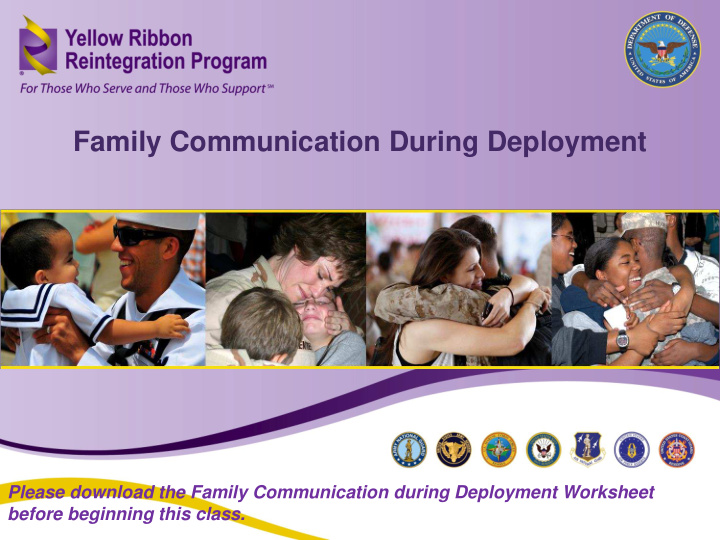



Family Communication During Deployment Please download the Family Communication during Deployment Worksheet before beginning this class. Family Communication during Deployment (MAR 2103)
What are the options? Care E-mail Packages Letters Phone Calls Video Private Chat Teleconference/Skype 2 Family Communication during Deployment (MAR 2103)
Letters & Care Packages Pros • Tried-and-true method for military families for hundreds of years! • Because they aren’t instant, they give people time to reflect on what they want to say. • Mementos from home can help the deployed person feel loved and remembered, and help him/her to stay connected. • Letters and care packages take a long time to go back and forth, and aren’t good for time -sensitive communications. • Because they are slow, letters may contain outdated information by the time they arrive, and don’t really allow for meaningful dialogue. Cons 3 Family Communication during Deployment (MAR 2103)
Email • Email is very quick and easy, and messages can be sent and received in a timely manner that allows for back-and-forth dialogue. Pros • Email can be retrieved from many places, including computers, tablets, and smart phones. • Because it is so fast, email can be impulsive. This can cause communication problems if messages are sent in the heat of the moment before the sender had a Cons chance to calm down or edit his/her thoughts. • Emails are often short and cryptic, which might lead to misinterpretation of the message. 4 Family Communication during Deployment (MAR 2103)
Phone & Online Communication Pros • These methods allow for “real time” rather than delayed communications. • Seeing and hearing each other can help to reduce family members’ fears and anxieties. • Skype might allow the deployed person to participate remotely in family events, such as a birthday party. • Visual contact might help very young children to keep their deployed parents “present”. Cons • In deployed areas, there might be significant limits on when, where, and how long people can talk. • For security reasons, there may be restrictions on what can be talked about. • Scheduling may be challenging, especially if time zones are very different. • Privacy may be lacking, limiting what people feel comfortable communicating about. • May end up feeling rushed and constrained. 5 Family Communication during Deployment (MAR 2103)
Instant Messaging Pros • “Real time” conversations. • It’s two -way communication. • You can respond and interact to other person’s comments. • Access in deployed regions can be restricted. • There may be a lack of privacy. • Sometimes these services are cut off suddenly causing additional worry. • Someone else may be doing the messaging when one of the parties is unaware. There is no visual and no guarantee the person in thought is the actual person doing the messaging allowing for misconceptions. Cons 6 Family Communication during Deployment (MAR 2103)
Communication During Deployment Everyone’s Goal: Keep in Touch Miscommunication: Putting out Fires 7 Family Communication during Deployment (MAR 2103)
Operational Security (OPSEC) 1. Your service member or unit’s mission 2. Deployment or movement “when” and “where” 3. Port call dates 4. The everyday goings on at home 5. Unit morale or personnel problems 6. The vacation you just got back from 7. Upcoming school/job/holiday plans 8. Upcoming family travel plans 9. The planned return date for Service Members 8 Family Communication during Deployment (MAR 2103)
Family Communication Plan If you have a communication plan, do you need to revise it? What kinds of things do you think should be covered in the communication plan based on what you have learned in this module? 9 Family Communication during Deployment (MAR 2103)
Recommend
More recommend